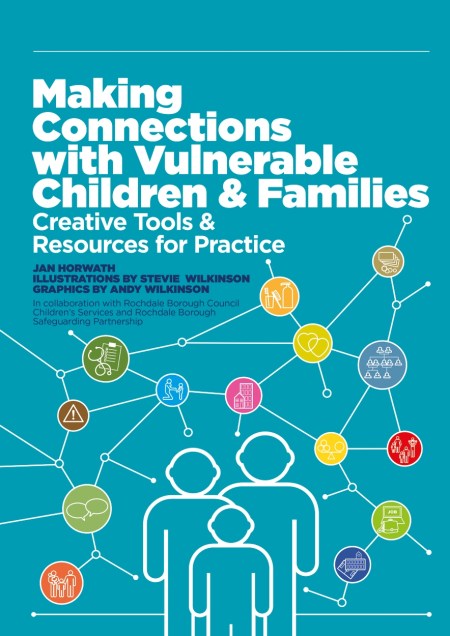Making Connections with Vulnerable Children and Families is the practical go-to resource for practitioners looking to build effective relationships and engage meaningfully with vulnerable children and their families.
Compiled by Jan Horwath, lead editor of the bestselling child protection handbook The Child’s World, the text features a wealth of clear, user-friendly, creative materials. The tools draw on evidence-based research and have been developed and tested by frontline practitioners from a range of disciplines working in Rochdale. Each tool includes a practice example as well as detail about aims, method, things to think about and possible adaptations. The tools can be used in a variety of work settings and the downloadable, versatile resources are all designed to support a relational approach to practice.
These tools will help you establish relationships with both children and their primary carers, understand their lived experience and the impact of this on the health and well-being of the child or adolescent. Additional tools are included for use with parents and primary carers to explore parenting capacity and the socio-economic factors that influence family life.
Compiled by Jan Horwath, lead editor of the bestselling child protection handbook The Child’s World, the text features a wealth of clear, user-friendly, creative materials. The tools draw on evidence-based research and have been developed and tested by frontline practitioners from a range of disciplines working in Rochdale. Each tool includes a practice example as well as detail about aims, method, things to think about and possible adaptations. The tools can be used in a variety of work settings and the downloadable, versatile resources are all designed to support a relational approach to practice.
These tools will help you establish relationships with both children and their primary carers, understand their lived experience and the impact of this on the health and well-being of the child or adolescent. Additional tools are included for use with parents and primary carers to explore parenting capacity and the socio-economic factors that influence family life.
Newsletter Signup
By clicking ‘Sign Up,’ I acknowledge that I have read and agree to Hachette Book Group’s Privacy Policy and Terms of Use
Reviews
This delightful compendium of creative ways to work with children, parents and carers is an incredible treasure trove of resources for any professional. It will be invaluable for new workers or students, but with my 35 years of experience I still found loads of new ways of working with children, from online support through to games and new ways of bringing old favourites like genograms to life, so I would recommend it as the perfect resource for anyone working with children and their families. This is partly because the wonderful illustrations and concrete case examples bring alive the approaches and is partly because there are just so many ideas here - it is bursting with exciting and interesting ways of working with children and families. The author, illustrator and the many workers and children who helped create this fantastic resource have done us all a huge service. Thank you!
It is essential that practitioners across services in Education, Social care, Fostering and Looked After Children's Services, Health, and Offending services develop the skills to make connections with vulnerable children, young people, and their parents. Jan Horwath, Steve Wilkinson, Andy Wilkinson and their many collaborators provide a comprehensive, detailed, accessible, gold mine of downloadable, practical tools culled from many sources, to promote effective communication. Most importantly, through guidance and extensive case histories the practitioner is introduced to approaches to connect effectively with vulnerable children and their families, using the tools to promote understanding of lived experiences and transform their lives.
I wish I had this book when I first qualified! It's packed with an impressive array of practical, evidence-based tools. Frontline social workers can easily grab this resource from their desks-right next to their cup of tea-before rushing out to see families. User-friendly and backed by useful examples, it's an essential companion for all social workers.
The Association of Child Protection Professionals welcomes this publication, which could prove invaluable to the newly qualified and less experienced practitioner seeking to develop their proverbial 'toolbox' of direct work examples.
There are many resources around for practitioners looking for ways to help them undertake 'direct work' with children and families, but Professor Horwath's book probably includes more ideas and applications all in one place. What I especially like is the book's emphasis on developing and maintaining an 'open, honest and trusting' connection with children and families. Without it, a compendium such as this could simply have become a 'toolkit', but the visible thread of 'relationships' gives this book a cutting edge.
A comprehensive and thoughtful guide that champions a collaborative, co-productive approach to working with vulnerable children and their families. Its emphasis on multidisciplinary cooperation, the lived experiences of children and carers, and the importance of relational, restorative practices makes it an invaluable resource for practitioners. The practical tools that have been developed in partnership with multi disciplinary professionals provide an evidence based approach to achieving better outcomes for children and families.
This excellent, helpful book provides wonderful guidance and practical tools to support practitioners to engage with and communicate effectively with children and young people and families. The chapter on digital communication and supporting children and young people in their use of the channels is especially helpful, especially for neurodiverse children and young people and those with learning disabilities. A must have for all those working with children, families and those who support them.
